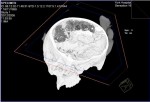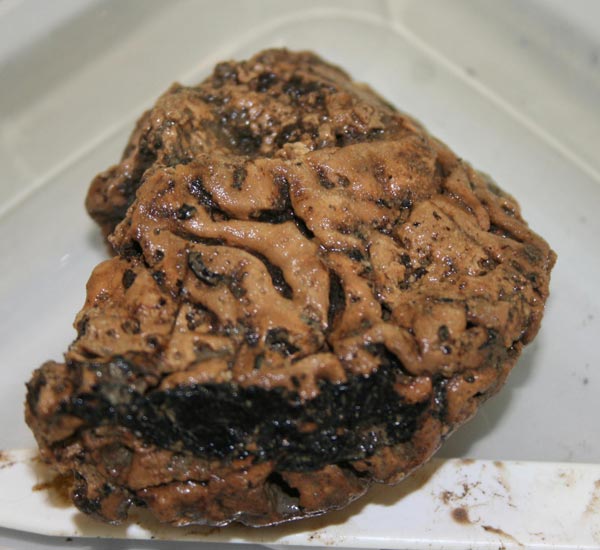In August 2008, archaeologists excavating an Iron Age pit on the grounds of the University of York discovered a skull with something rattling around in it. Finds Officer Rachel Cubitt peered inside and saw an odd yellow substance. That substance turned out to be a brain.
Cubitt recalled a lecture she had attended by Dr. Sonia O’Connor — who had discovered 25 medieval skeletons with preserved brains a decade earlier — about rare instances of ancient brain matter surviving even when the rest of the soft tissues decayed, so she ensured the skull was treated with special care and contacted Dr. O’Connor for further research.
 They took it to York District Hospital for CT scans and other tests and confirmed the presence of brain matter. The brain had shrunk to a quarter of its original size, but the cerebral structures were still clearly identifiable. Transmission electron microscopy examination revealed tubules like the myelin ones found around neurons, and chemical analysis indicated the presence of peptides found in neurofilaments.
They took it to York District Hospital for CT scans and other tests and confirmed the presence of brain matter. The brain had shrunk to a quarter of its original size, but the cerebral structures were still clearly identifiable. Transmission electron microscopy examination revealed tubules like the myelin ones found around neurons, and chemical analysis indicated the presence of peptides found in neurofilaments.
Organs have been found before in decent states of preservation, but they’re usually the results of mummification, natural or man-made, or freezing, and in those cases other soft tissues survive as well. To find a brain inside a skull with no other non-skeletal remains is extremely rare.
“It was just amazing to think that a brain of someone who had died so many thousands of years ago could persist just in wet ground,” said Sonia O’Connor, a postdoctoral research fellow at the University of Bradford. O’Connor led a team of researchers who assessed the state of the brain after it was found in 2008 and looked into likely modes of preservation.
“It’s particularly surprising, because if you talk to pathologists who deal with fresh dead bodies they say the first organ to really deteriorate and to basically go to liquid is the brain because of its high fat content,” O’Connor said.
When it was found, the skull — which belonged to a man probably between 26 and 45 years old — was accompanied by a jaw and two neck vertebrae, bearing evidence of hanging and then decapitation. Cut marks on the inside of the neck indicate that the head was severed while there was still flesh on the bones, O’Connor said. There is, however, no indication of why he was hanged, and the rest of his remains have yet to be found.
What appears to have happened in this case is the body was buried very soon after death in its watery grave. The anaerobic environment — and possibly some physiological factors like disease or starvation during life — kept the brain from putrefying. Over time it shrank and changed from soft, fatty tissue to a rubbery, durable material.
Studies are ongoing, but the brain has been dated to between 673 and 482 B.C., about 500 years older than the initial assessment. This is definitely the oldest brain ever found in Britain. It’s hard to compare to other such finds because, surprisingly, there hasn’t really been a comprehensive study of the phenomenon of preserved brains. O’Connor’s team is compiling a list of similar finds over the past 50 years for a study in the Journal of Archaeological Science.
When I wrote about this discovery back when it was first reported, the only picture I had was the above CT scan. Now there’s a big juicy brain to show, sitting on a plate looking like an especially gross Halloween Jell-O mold. :boogie:
